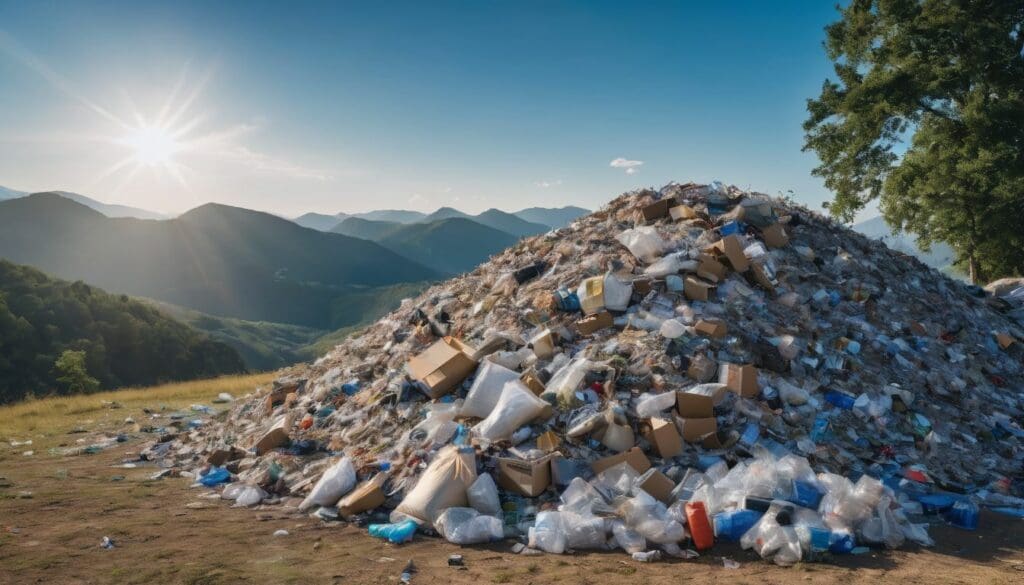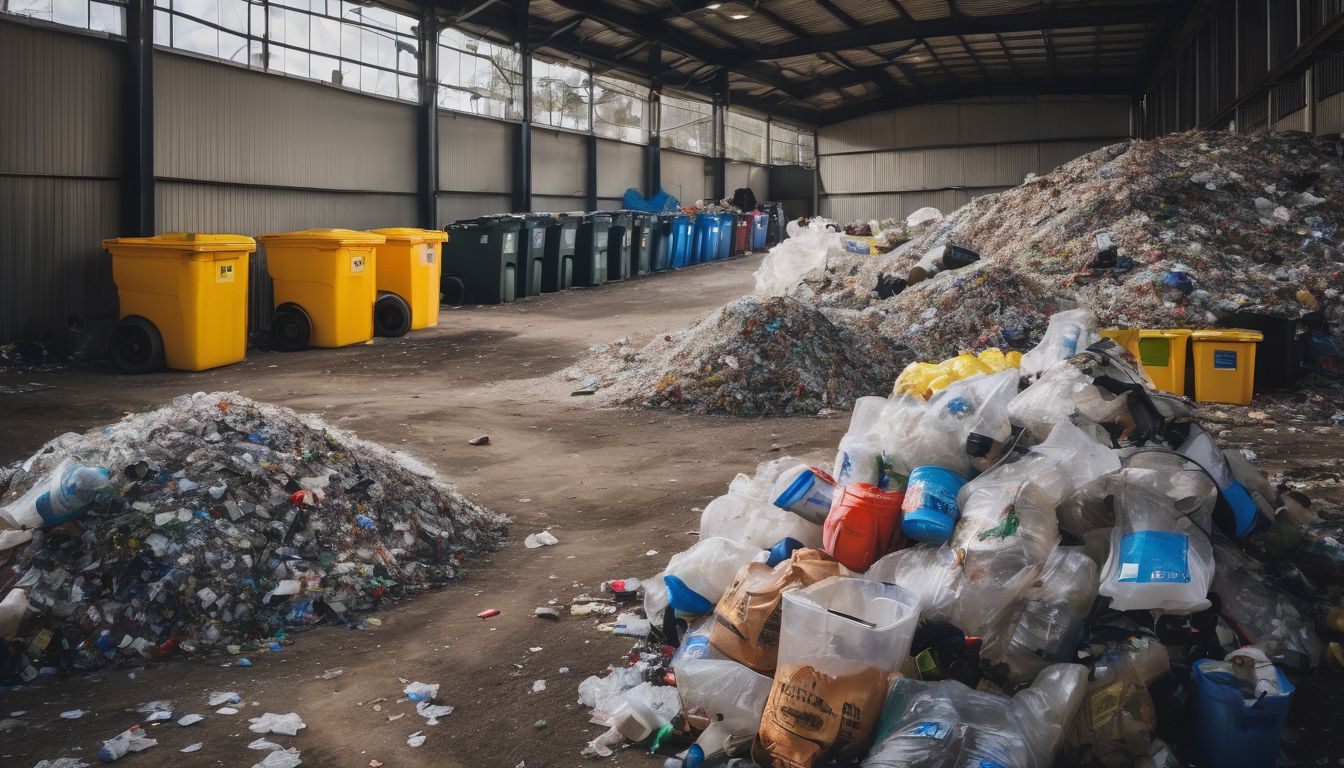It’s widely known that recycling can help our planet, yet many of us wonder just how much difference it truly makes. Each year, the recycling industry prevents millions of tonnes of carbon emissions from entering the atmosphere.
This article delves into the positive impact your recycling efforts have on shrinking that all-important carbon footprint. Read on and find out how tossing that tin can into the blue bin contributes to a healthier Earth!
Key Takeaways
- Recycling reduces the carbon footprint by using less energy and resources than producing new materials, significantly decreasing greenhouse gas emissions.
- Utilising renewable energy sources for recycling processes, such as solar and wind power, contributes to a further reduction in carbon emissions.
- The efficiency of the recycling process can be improved with advanced technology and optimised transportation logistics, which in turn minimises its environmental impact.
- Different materials like paper, plastics, glass, metals and electronics have varying levels of recyclability; efficient recycling of these materials conserves natural resources and lowers demand for raw material extraction.
- By diverting waste from landfills through recycling efforts, methane emissions are reduced and valuable landfill space is preserved.
What is a Carbon Footprint?
A carbon footprint is the amount of greenhouse gases, particularly carbon dioxide, released into the atmosphere as a result of human activities. It is measured by assessing the total amount of emissions produced directly and indirectly by an individual, organisation or product.
Definition
A carbon footprint refers to the total amount of greenhouse gases, including carbon dioxide and methane, that are emitted by an individual, event, organisation, service or product.
These emissions contribute significantly to climate change as they trap heat in the atmosphere. Measuring a carbon footprint is essential for understanding environmental impact and driving sustainable practices.
To calculate this figure, experts take into account all sources of emission throughout a product’s life cycle or during specific activities. This comprehensive approach helps to pinpoint where reductions can be made, guiding efforts towards more eco-friendly choices and lower ecological footprints.
It’s a vital step in managing our contributions to global warming and moving towards sustainability.
How it is measured
To measure the carbon footprint of recycling, experts use life cycle assessment (LCA) tools. LCA evaluates the environmental impact of products or services at every stage of their life cycle, from raw material extraction to manufacturing and disposal.
This method considers factors like energy usage, emissions, and waste generation throughout the entire process.
Additionally, specific carbon footprint calculators are available for measuring individual activities such as recycling. These tools take into account various parameters such as type and quantity of materials recycled, transport distances for collection and processing, and energy sources used during recycling.
The Impact of Recycling on Carbon Footprint
Recycling has a positive impact on reducing carbon footprint as it involves less energy and resources compared to producing new materials. This results in reduced greenhouse gas emissions and helps in mitigating climate change.
Comparing recycled vs. non-recycled materials
Understanding how recycling differs from using non-recycled materials is crucial for those of us passionate about conservation and environmental protection. Here’s a concise comparison:
| Aspect | Recycled Materials | Non-Recycled Materials |
|---|---|---|
| Energy Consumption | Less energy required. | Higher energy demands. |
| Greenhouse Gas Emissions | Significantly reduced emissions. | More emissions during production. |
| Resource Depletion | Conserves natural resources. | Uses virgin resources, depleting them over time. |
| Environmental Impact | Lower overall negative impact. | Greater potential for environmental harm. |
| Cost of Production | Often lower due to less processing. | Tends to be higher with extraction and refinement costs. |
| Waste Production | Minimises waste through re-use. | Generates more waste materials. |
Each decision to recycle represents a step towards a more sustainable planet.
Reduction in greenhouse gas emissions
By choosing to recycle materials, you contribute to the reduction in greenhouse gas emissions. Recycling helps to cut down on the amount of energy required for manufacturing products from raw materials, thereby decreasing carbon dioxide and other greenhouse gases released into the atmosphere.
By reducing these harmful emissions, recycling plays a vital role in mitigating climate change and preserving our environment for future generations.
The process of recycling materials leads to fewer carbon emissions than producing new items from raw materials. This is because recycled materials generally require less processing and energy consumption, contributing significantly to lower levels of greenhouse gas emissions.
Energy savings
Recycling significantly reduces energy consumption. Processing raw materials from scratch requires large amounts of energy. However, recycling uses much less energy as it utilises already processed materials which have gone through the initial production phase.
By choosing recycled products, individuals actively contribute to lower energy requirements and reduced carbon emissions in the manufacturing process.
Opting for recycled goods leads to a considerable reduction in greenhouse gas emissions too since less energy is used in the manufacturing process due to the use of recycled materials.
Benefits of Recycling for the Environment
Recycling benefits the environment by reducing climate change, minimising waste, and preserving landfill space. It also promotes resource conservation and supports sustainable living practices.
Reducing climate change
Recycling plays a crucial role in reducing climate change by decreasing the need for new raw materials, which in turn reduces energy consumption and carbon emissions. The process of recycling produces fewer greenhouse gas emissions compared to producing items from scratch.
By recycling, we can contribute to lessening the impact of global warming and preserving natural resources for future generations. Additionally, when we recycle materials like paper and plastic, it lowers the demand for logging and oil extraction, further mitigating the effects of climate change.
The reduction in greenhouse gas emissions through recycling is pivotal in addressing environmental challenges such as global warming. Recycling helps to lower carbon emissions, thereby helping to mitigate climate change by minimising reliance on fossil fuels and curbing deforestation.
Waste reduction
Recycling plays a key role in waste reduction by diverting materials from landfills, conserving natural resources, and minimising the need for new production. By reducing the amount of waste sent to landfills, recycling lessens methane emissions and preserves landfill space.
This practice also alleviates the demand for raw materials and manufacturing processes, contributing to overall carbon footprint reduction.
Opting for recycled products minimises the need for new resource extraction while promoting a circular economy that reduces environmental strain. Consequently, embracing sustainable practices like recycling can significantly mitigate greenhouse gas emissions and contribute to a healthier environment.
Landfill space preservation
Recycling helps preserve landfill space by diverting recyclable materials from ending up in landfills. This reduces the amount of waste that needs to be buried, conserving valuable land and reducing the environmental impact of waste disposal.
By recycling, we can decrease the need for more landfill sites and extend the lifespan of existing ones, contributing to sustainable waste management practices.
Additionally, the preservation of landfill space through recycling supports renewable resource use and minimises the ecological footprint associated with creating new landfills. It also lessens methane emissions from decomposing organic waste in landfills, thereby mitigating greenhouse gas contributions to climate change.
Factors Affecting the Carbon Footprint of Recycling
The types of materials being recycled, the efficiency of the recycling process, and the energy sources used for recycling all play a role in determining the carbon footprint of recycling.
To learn more about how these factors impact the environment, continue reading.
Types of materials being recycled
When considering the types of materials being recycled, it’s important to understand that the following are commonly recycled:
- Paper and Cardboard: These materials can be processed and reformed into new paper products, reducing the demand for virgin fibre.
- Glass: Recycling glass not only conserves raw materials but also reduces energy consumption in the production of new glass items.
- Plastics: Recycling plastics lessens the environmental impact of plastic production and helps mitigate plastic pollution.
- Metals: Recycling metals such as aluminium and steel significantly saves energy compared to refining raw materials.
- Electronics: Proper recycling of electronic waste prevents hazardous substances from entering the environment and recovers valuable resources.
Recycling process efficiency
To reduce the carbon footprint of recycling, improving the efficiency of the recycling process is vital. Efficient sorting and processing of recyclable materials helps to minimise energy consumption and greenhouse gas emissions.
Utilising advanced technology and machinery for sorting and processing can further enhance the efficiency of recycling facilities, leading to significant reductions in carbon emissions.
Optimising transportation logistics also plays a crucial role in enhancing the efficiency of the recycling process. Minimising transportation distances between collection points, recycling facilities, and end markets reduces fuel consumption and associated carbon emissions.
Implementing streamlined transportation routes and utilising eco-friendly vehicles for transporting recyclable materials can contribute to a more efficient recycling process while reducing its overall environmental impact.
Energy sources for recycling
When considering the carbon footprint of recycling, it is crucial to evaluate the energy sources used in the recycling process. Renewable energy sources such as solar and wind power play a vital role in reducing greenhouse gas emissions from recycling.
By utilising clean energy sources, the environmental impact of recycling can be further minimised, contributing to sustainable practices and waste management. Additionally, incorporating renewable materials into the recycling process can significantly reduce carbon emissions associated with traditional manufacturing processes.
Another aspect affecting the carbon footprint of recycling is the use of efficient energy sources during material reprocessing. This efficiency directly impacts overall greenhouse gas emissions from the recycling industry.
Conclusion
Understanding the Carbon Footprint of Recycling raises awareness about emissions reduction. It highlights the pivotal role of recycling in reducing carbon emissions. The impact of recycling on global warming is a crucial aspect to consider, and sustainable practices play a vital role in waste management and carbon footprint reduction.
Understanding this connection empowers environmentally conscious individuals to support conservation and make informed choices for the environment.
FAQs
1. What is the carbon footprint of recycling?
The carbon footprint of recycling refers to the amount of carbon emissions produced during the process, which can affect climate change.
2. Does recycling reduce my carbon footprint?
Yes, recycling helps in reducing your carbon footprint by cutting down on emissions from waste management and supporting sustainable practices.
3. How does recycling impact global warming?
Recycling has a positive impact on global warming as it leads to emissions reduction by reprocessing materials instead of manufacturing new ones.
4. Can understanding the effects of recycling help our environment?
Understanding how recycling affects the environment can guide us towards more effective sustainable practices that benefit both climate and ecosystem health.





